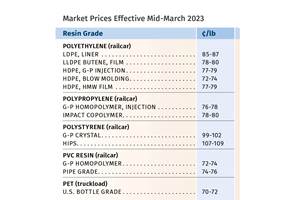Polyplastics to Highlight Expanded Product Portfolio at K 2022
The company will also highlight its material supply capabilities.

At the upcoming K 2022, engineering thermoplastics manufacturer Polyplastics Group will showcase the latest developments in it Duracon POM, Topas COC, and Laperos LCP product lines and will address the demanding end-use requirements in the medical, electrical/electronics, and automotive industries. With full acquisition by Daicel in 2020, Polyplastics has expanded its options for growth and geographical market coverage. It has expanded LCP sales to EMEA and the Americas while making timely investments in capacity to better respond to market growth. Among the materials to be highlighted are three introductions made this year, as previously reported:
▪ Duracon Polyacetal: The newly expanded Duracon POM PM series was developed for drug contact and delivery applications, and complements the company’s Topas COC (cyclic olefin copolymer) product—a high-purity material for a range of medical applications.
The newest Duracon PM line offering is high-flow grade PM27S01N, which reportedly offers reduced wall thickness, miniaturization, and lower weight for various medical devices that are becoming increasingly complicated and highly functional. The PM series also includes Duracon PM09S01N, a standard viscosity grade.
▪ Plastron LFT-PP: This long-fiber-reinforced-thermoplastic (LFT) made with specially formulated regenerated cellulose fibers reportedly provides weight reduction plus mechanical strength, enabling manufacturers to reduce their carbon footprint and meet today’s sustainability demands. Cellulose is a promising material to help reduce CO2 emissions but its insufficient strength is a limiting factor. Polyplastics has addressed this problem by using regenerated cellulose in the development of LFT resins with an excellent balance of physical properties.
A comparison of long-fiber cellulose-reinforced PP resin versus long-fiber glass-reinforced PP resin at the same flexural modulus shows that cellulose-reinforced resin has lower density than glass-filled resin. While long-fiber cellulose-reinforced PP resin has a flexural modulus roughly 3% higher than that of 30% long-glass reinforced PP resin, it exhibits higher values for Charpy impact strength, tensile strength, and flexural strength, thus indicating potential for upgraded strength.
▪ Durast 3D powders: This new series of engineering plastic fine powders are compatible with a broad range of manufacturing methods. The company has expanded its lineup with Durast Powders which go beyond traditional injection molding and extrusion and are targeted for low-volume production of complex parts utilizing sinter forming, compression molding, and 3D printing. Durast Powders made of POM, PPS, PBT, and LCP reportedly have a unique spherical shape and are controlled for fine, narrow particle size distribution (10 μm-200 μm). Engineering plastics in powder form permit the use of manufacturing methods that were previously impossible with pellet shapes, making it possible to impart the strengths of engineering plastics and additional performance attributes
Polyplastics will also highlight its expanded global supply capability which includes planned construction of a new polyacetal manufacturing plant in Nantong Economic Development Zone, Jiangsu Province, China. The production capacity is planned to be 330.7 million lbs in total in two stages. The new capacity will satisfy growing demand for POM, improve lead times, and reduce transportation costs. The initial start-up of 198.4 millon lbs is expected in November 2024.
Buoyed by strong growth in electrical/electronics, Polyplastics’s LCP business plans to construct a new polymerization plant with production capacity of 10 million lb/yr at Polyplastics Taiwan Co., Ltd. It is expected that LCP applications will continue to expand with the full-scale adoption of 5G and millimeter-wave devices.
Polyplastics will also highlight the strong growth for COC (particularly for use in medical devices) which will be supported by construction of a new production facility in Leuna, Germany. The new plant, to be operated by local Polyplastics subsidiary Topas Advanced Polymers GmbH, will have a capacity of 44 million lb/yr, adding significant room for growth beyond the current output. The facility will be operational by latter half of 2024.
Related Content
Tracing the History of Polymeric Materials, Part 26: High-Performance Thermoplastics
The majority of the polymers that today we rely on for outstanding performance — such as polysulfone, polyethersulfone, polyphenylsulfone and PPS — were introduced in the period between 1965 and 1985. Here’s how they entered your toolbox of engineering of materials.
Read MoreScaling Up Sustainable Solutions for Fiber Reinforced Composite Materials
Oak Ridge National Laboratory's Sustainable Manufacturing Technologies Group helps industrial partners tackle the sustainability challenges presented by fiber-reinforced composite materials.
Read MoreNPE2024 Materials: Spotlight on Sustainability with Performance
Across the show, sustainability ruled in new materials technology, from polyolefins and engineering resins to biobased materials.
Read MorePrices of Volume Resins Generally Flat or Lower
Exceptions in early March were PP and PS, which moved up solely due to feedstock constraints, along with slight upward movement in PVC and PET.
Read MoreRead Next
See Recyclers Close the Loop on Trade Show Production Scrap at NPE2024
A collaboration between show organizer PLASTICS, recycler CPR and size reduction experts WEIMA and Conair recovered and recycled all production scrap at NPE2024.
Read MorePeople 4.0 – How to Get Buy-In from Your Staff for Industry 4.0 Systems
Implementing a production monitoring system as the foundation of a ‘smart factory’ is about integrating people with new technology as much as it is about integrating machines and computers. Here are tips from a company that has gone through the process.
Read MoreFor PLASTICS' CEO Seaholm, NPE to Shine Light on Sustainability Successes
With advocacy, communication and sustainability as three main pillars, Seaholm leads a trade association to NPE that ‘is more active today than we have ever been.’
Read More















